Passages en passant
presenteert
Fatima Barznge & Mirjam Somers
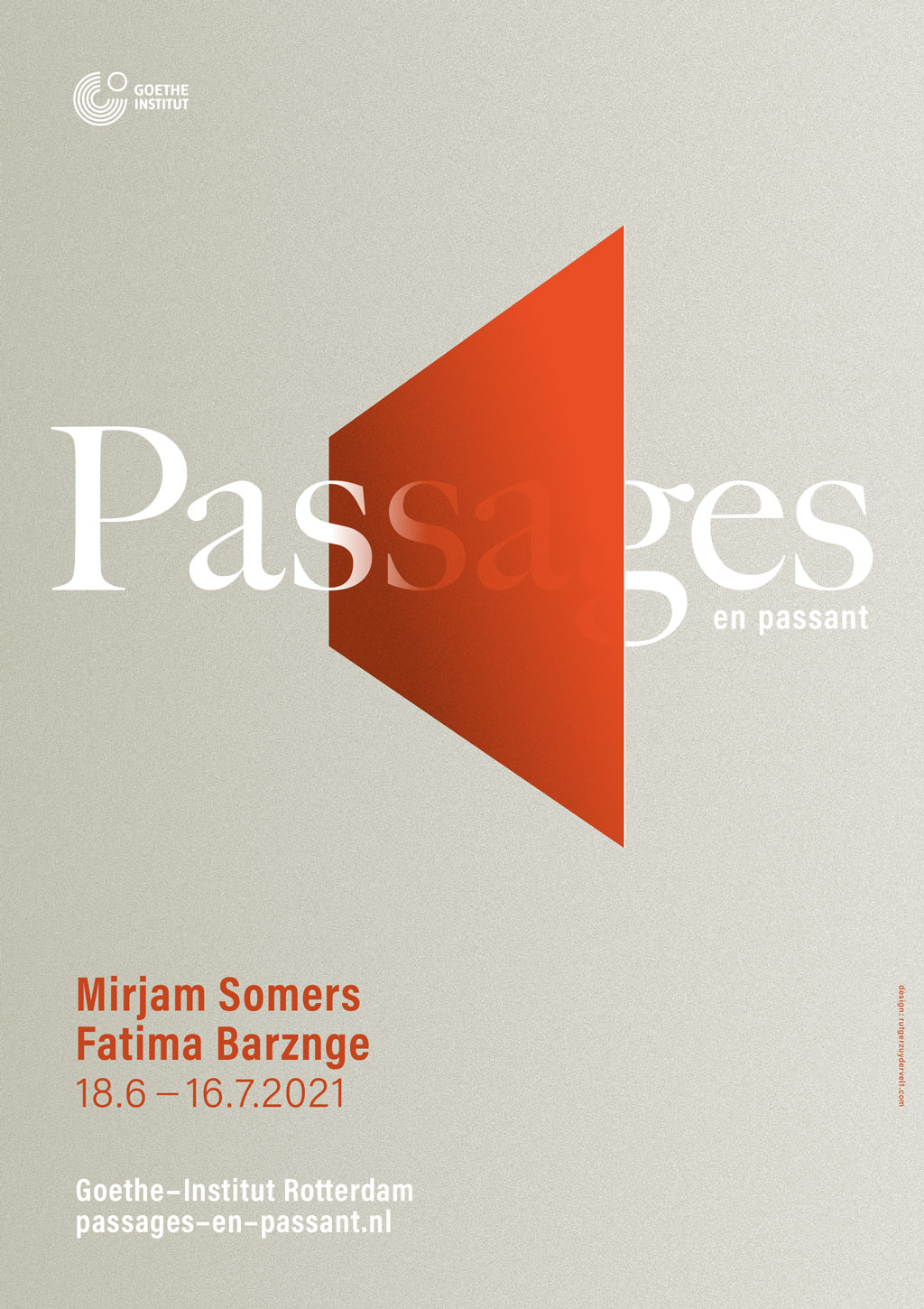
Passages en passant is een reeks tentoonstellingen in de gang van het Goethe-Institut Rotterdam waarbij iedere keer de werken van twee kunstenaars in dialoog met elkaar treden.
Dit format is bedoeld als ruimte voor uitwisseling met en door de werken, aanleiding tot gesprek en als ontmoetingsplek voor geïnteresseerden.
In deze eerste tentoonstelling tonen wij werk van
Mirjam Somers en Fatima Barznge.
Van vrijdag 18 juni t/m vrijdag 17 juli.
Je bent van harte welkom.
Voor het openingswoordje van 17:00 – 17:30 uur kunnen 15 mensen reserveren door zich in te schrijven via info-rotterdam@goethe.de.
Goethe-Institut Rotterdam
Westersingel 9
3014GM Rotterdam
OPENINGSTIJDEN
maandag, dinsdag, donderdag, vrijdag: 10:00-14:30
en op afspraak
Click for English
Passages en passant is a series of exhibitions in the corridor of the Goethe-Institut Rotterdam, each time showing the works of two artists in dialogue with each other.
This format is intended as a space for exchange with and through the works, a trigger for conversation and a meeting place for interested people.
In this first exhibition, we are showing works by
Mirjam Somers and Fatima Barznge.
From friday 18 july until friday 16 july.
You are warmly invited.
Goethe-Institut Rotterdam
Westersingel 9
3014GM Rotterdam
OPENING HOURS
Monday, Tuesday, Thursday, Friday: 10:00- 14:30
and by appointment
Fatima Barznge
Het uitgangspunt in het werk van Fatima Barznge is de herinnering. In haar schilderijen en werken op papier herbeleeft ze de plaatsen, voorwerpen en sferen van een geboorteplaats, culturele wereld en kindertijd waarnaar terugkeren onmogelijk is.
Lees meer over de serie Study of Square / To my Generation
Sinds 2017 is mijn onderwerp het vierkant en alle werken zijn gemaakt in een vierkant formaat. Het achterliggende idee en inspiratie voor dit onderwerp is het vierkant in de geometrische islamitische kunst waarin het vierkant de basisvorm is van uitgebreide patronen in de architectuur, tegels, mozaïek, wanddecoratie, textiel…etc. In mijn werk neem ik dat idee over en maak ik mijn eigen interpretatie.
Study of Square / To my generation
Het idee achter deze serie werken komt van de vorm waarop in de islamitische traditie/generatie van mijn ouders, de naam van god op tegels, op andere materialen en voorwerpen versiert als een souvenir. Versiering en souvenir worden gelinkt met en symboliseren de reis en het paradijs. Zo worden 99 namen van God afgebeeld, om god dichtbij te dragen en zich hem te herinneren. Dit principe breng ik over naar mijn situatie waarin ik 100 namen van mensen op papier heb geschilderd, die ik persoonlijk waardeer en die ik dichtbij wil houden. Mensen die indruk op mij hadden en hebben gemaakt. Namen waar ik een bepaalde herinnering aan heb in het verleden. Deze namen zijn Midden- Oosterse en Westerse kunstenaars, schrijvers, filosofen, wetenschappers, dichters, componisten, regisseurs, acteurs en zangers. In dit werk laat ik ook bij sommige namen zien hoe Oost en West elkaar inspireren.
The ruling principle in the work of Fatima Barznge is memory. In her paintings and works on paper she revisits the places, objects and atmospehers of a birthplace, cultural world and childhood to which return is impossible.
Read more about the Study of Square / To my Generation series
Since 2017 the square is my subject and all works are made in a square format. The underlying idea and inspiration for this subject is the square found in geometric Islamic art, in which it is the foundational form of elaborate patterns in architecture, tiles, mosaics, wall decorations, textiles…etc.
In my work, I take this idea and I make it my own.
Study of Square / To my generation
The idea behind this series of works comes from the form in which within the Islamic tradition/generation of my parents, the name of god is decorated on tiles, on other materials and objects as a souvenir. Decoration and souvenir are linked to and symbolize the journey and paradise. Thus 99 names of God are depicted, to carry god close and remember him. I transfer this principle to my situation where I have painted on paper 100 names of people whom I personally appreciate and want to keep close. People who had and have made an impression on me. Names that I have a particular memory of in the past. These names are of Middle Eastern and Western artists, writers, philosophers, scientists, poets, composers, directors, actors and singers. In this work, I also show how East and West inspire each other with some of the names.
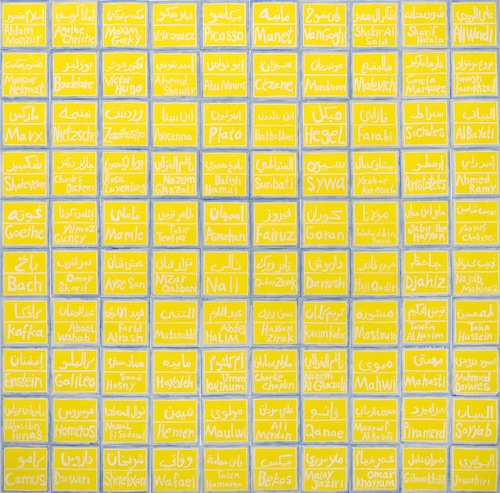
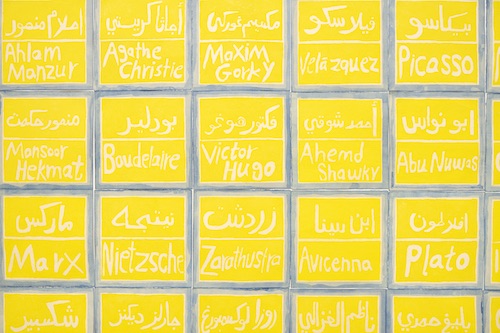
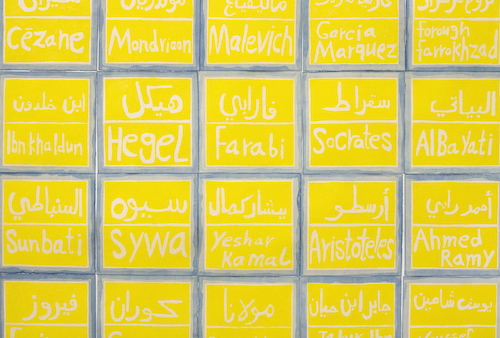
Study of Square / To my generation
2020
Study of Square / To my generation
2020
Study of Square / To my generation
2020
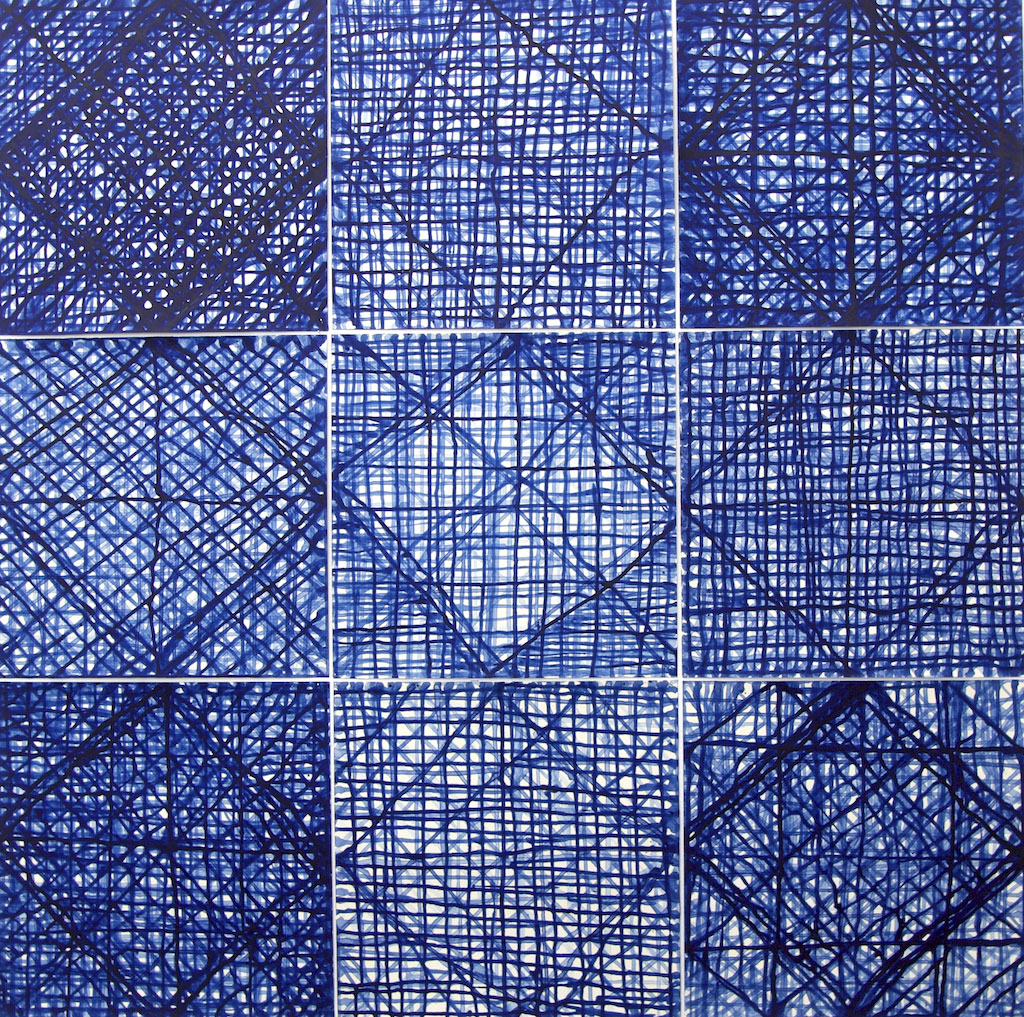
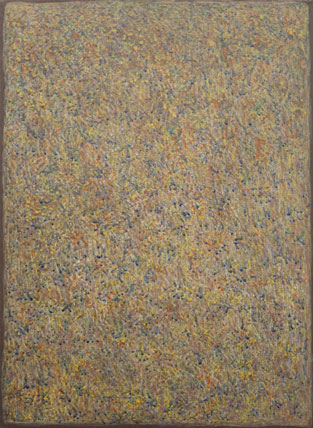
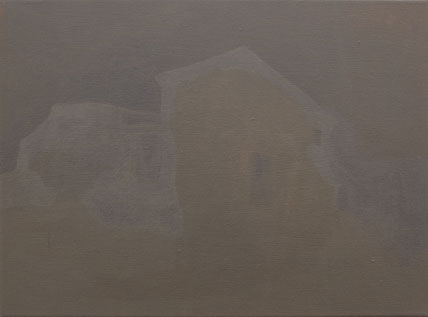
Study of Square
2021
Untitled
2016
A house from clay
2015
Mirjam Somers
Mirjam Somers maakt tekeningen en videowerken met als thema de relatie tussen mens en dier, soms ontroerend, vaak ook verontrustend. In haar werk zoekt ze zowel het absurdistische als het poëtische.
Lees meer over de serie Daily Drawings
Who hath charity? This bird.
Who suffereth long and is kind,
Is not provoked, though blind
And alive ensepulchred?
Who hopeth, endureth all things?
Who thinketh no evil, but sings?
Who is divine? This bird.
Thomas Hardy
Het dier betekent alles voor beeldend kunstenaar Mirjam Somers (1971). Het engagement tussen dier en mens, hun lotsverbondenheid en hun beider bestaansrecht zijn onlosmakelijk verbonden met haar kunstenaarschap. Ooit waren mens en dier elkanders gelijke en deelden ze op rechtvaardige wijze dezelfde ruimte. Maar geleidelijk aan veranderde er iets in die natuurlijke positionering. De mens wierp zich op als heer en meester over de schepping: dier en natuur werden onderworpen aan zijn dadendrang. Hij zwaaide vanuit zijn hoge mate van zelfbewustzijn de scepter zodanig hardhandig, dat er voor het dier nauwelijks meer vluchtroutes overbleven. Verdreven uit ontboste jungles, doodgereden langs snelwegen, beroofd van hun ivoren hoorns, tentoongesteld in afgerasterde dierentuinen of samengeperst in ligboxenstallen. De aloude symbiose tussen beide aardlingen werd stilaan verstoord. Het ravijn tussen dier en mens verdiepte zich en op een dag stonden ze verweesd tegenover elkaar, als gemankeerde zielsverwanten in afgebakende werelden. Ongenaakbaarder had de relatie tussen deze zoogdieren, die elkaar in essentie zo goed aanvoelen, niet kunnen eindigen. Het dier is diep onrecht berokkend en leeft sindsdien in wezen in onmin met de medemens.
Mirjam Somers werd van jongs af aan gepijnigd door deze dieronvriendelijke houding van de mens. Ze wilde op de barricades voor ‘de ontmenselijking’ van het dier. En dat deed ze ook, met dien verstande dat haar barricade er anders uitziet dan de doorgaans obstructieve wegversperringen.
Somers’ ‘strijdtoneel’ heet kortweg Daily Drawings, een dagelijks terugkerend ritueel waarbij aquarelpapier van A4formaat, penselen, acrylverf, houtskool, kleurpotloden, pastelkrijt en retoucheerverf de basisingrediënten vormen. Gedisciplineerd verschanst zij zich na een ochtendwandeling in de beslotenheid van haar atelier, waar de cadans van muziek nooit afwezig is. En met de eerste streken en vegen op papier gaat elke dag een nieuwe reis van start, beïnvloed door haar eigen gemoedstoestand en beelden die zij uit haar fotoarchief en historische familiealbums opdiept of uit krantenartikelen haalt. Een waarachtig avontuur, omdat van te voren niet vaststaat hoe het parcours zijn verloop krijgt. Het resultaat is een aaneenschakeling van exploraties die, dat staat buiten kijf, niet zelden uitmonden in door de ziel snijdende scènes, soms met een onthutsend horror-gehalte.
Zoals de pandemie de wereld sinds maart 2020 in haar greep heeft, lijken de kleinformaat eenakters de kijker stuk voor stuk bij de kraag te willen grijpen. Ontreddering, vervreemding, onbehagen of vermomming zijn hun deel. Gemuilkorfde dieren en gemaskerde gedaantes in witte pakken vormen een terugkerend thema. Ze lijken verankerd in hun eigen slagschaduw, gestold in een terra incognita, waaraan geen ontsnapping mogelijk is. Af en toe weten ze zich ingebed in summiere tekstjes, die niet per se een verhaallijn uitstippelen, maar eerder fungeren als fluisteringen op de achtergrond. Daily Drawings ging in de lente van 2020 van start en is inmiddels uitgegroeid tot 200 visuele dagboekfragmenten: minuscule universums zonder noemenswaardige context. Ze confronteren ons met een gekerkerde tijd waarin de nacht voorgoed lijkt te zijn ingedaald en ons aangeharkte leven op losse schroeven is komen te staan. In de registraties zijn mens en dier soms met elkaar versmolten tot tussenwezens: boven de schouders van de mens balanceert een kraaienhoofd of het menselijke gelaat heeft plaatsgemaakt voor een konijnensnuit met hangende flaporen. Alsof Somers de breuk tussen de homo sapiens en zijn dierlijke evenknie wil helen, opdat de verwevenheid van weleer terugkeert. Alsof ze wil zeggen: verzoening is nog mogelijk, zoals in het verstilde onderonsje tussen een reiger en een clown aan de oever van de Schie.
In haar blikveld doemen bij tussenpozen mildere momenten op: een pootjes gevende hond die wordt verrast door een roodborstje of een aap die met een sneeuwpopje speelt. Of ze schuift bloedrode kersen onder haar vergrootglas, indachtig de kersentuin van haar grootmoeder. Hoe vreugdevol was het destijds om kersenpitten te kunnen spugen!
Daily Drawings zijn iconen van een tijdspanne waarin existentiële bespiegelingen ons overrompelen, een tijd om bij stil te staan en een tijd om verloren te laten gaan. Urgentie is het trefwoord voor deze stillevens. Ze rijgen zich aaneen als filmscènes in een lange verontrustende film, waarin stiltes en sirenes elkaar afwisselen.
Tekst Ida Jager
Mirjam Somers makes drawings and video works about the relationship between humans and animals, sometimes touching, often disturbing. In her work, she seeks both the absurd and the poetic.
Read more about the Daily Drawings series
Who hath charity? This bird.
Who suffereth long and is kind,
Is not provoked, though blind
And alive ensepulchred?
Who hopeth, endureth all things?
Who thinketh no evil, but sings?
Who is divine? This bird.
Thomas Hardy
Animals mean everything to the artist Mirjam Somers (1971). The connection between animals and people, the bonds of fate that bind them together and their mutual right to existence are linked indissolubly in her art. Long ago, men and animals were like one another and shared the earth fairly together. But gradually a change in this natural relationship came about. Man thrust himself into the role of lord and master of creation; animals and nature became subject to the force of his actions. So overweening was his self-confidence and so hard his rule, that animals were scarcely left any place of escape. They were driven out of jungles by deforestation, run over and left for dead along highways, robbed of their horns for ivory, shown off behind railings in zoos or jammed together in cattle pens. In due course the age-old symbiosis between these two sharers of the earth became eroded. So deep did the chasm grow between animals and men that in time they came to seem like kindred spirits who have drawn away into totally separate worlds. The relation between these mammals, who might really co-exist so well, could hardly have ended in their growing further apart. Animals have suffered a big injustice; at heart they live now in discord with their fellow-creature, man.
Since childhood onwards, Mirjam Somers has found this unfriendly attitude of men towards beasts distressing. She wanted to go to the barricades for the ‘dehumanization’ of animals. She did so in her own way; her barricade would not be the usual obstructive type of road-block. Somers gave her scene of battle the simple name of Daily Drawings, a ritual repeated each day on A4 watercolour paper, using brushes, acrylic paint, charcoal, coloured pencils, pastel crayons and retouching tones as the basic ingredients. After a morning walk, she closets herself firmly in the fortress of her studio, always with the cadence of music for company. With the first lines and strokes on paper she starts on a new journey every day, under the influence of her own state of mind and of pictures which she digs out from her photo collection, from old family albums, or from newspaper articles. A genuine adventure, since it’s not clear in advance how her journey will develop. The result is a sequence of explorations that often end in undeniably heart-wrenching images, sometimes with an ingredient of distress or horror.
Like the pandemic that has gripped the world since March 2020, these single, small-format scenes seem to want to take the viewer by the throat, one by one. Disarray, alienation, discomfort or concealment are ever-present. Muzzled beasts and masked figures in white are a recurring theme. They seem trapped within the shadow they cast, fixed in a terra incognita from which there is no escape. Sometimes they are enclosed in short texts. These set out no special storyline. They seem to function instead like whisperings in the background.
Starting in the Spring of 2020, Daily Drawings has expanded thus far to 200 fragments from a visual diary: tiny universes with no context to speak of. They confront us with a period of imprisonment in which it seems to be permanently night and the steadiness of our lives has become completely unsettled. Man and beast in these pictures have sometimes been fused together in an in-between state of existence: a crow’s head balances on top of one man’s shoulders, while the face of another man makes way for the snout and drooping ears of a rabbit. It’s as if Somers is trying to heal the fissure between homo sapiens and his animal counterparts and restore the old interconnection between them. As if she wished to say: reconciliation is still possible – as shown, for example, in one quiet exchange between a heron and a clown on the banks of the Schie.
At intervals, gentler moments slip into her field of vision: a dog stretches out its paw and is surprised by a robin, or an ape plays with a small snowman. Or she places bright-red cherries under her magnifying glass, remembering her grandmother’s cherry orchard. What fun in those days to spit out the cherry stones!
Daily Drawings are icons of a time when reflections on our existence have overwhelmed us, a time to be still, and a time to let go. The word that is the key to these still-lives is urgency. They thread together like scenes from a long and disturbing film, filled with the alternation of silences and the sound of sirens.
Text: Ida Jager
Translation: Andrew Saint



Vogelman
2021
De waterige stad
2021
Transporting
2021
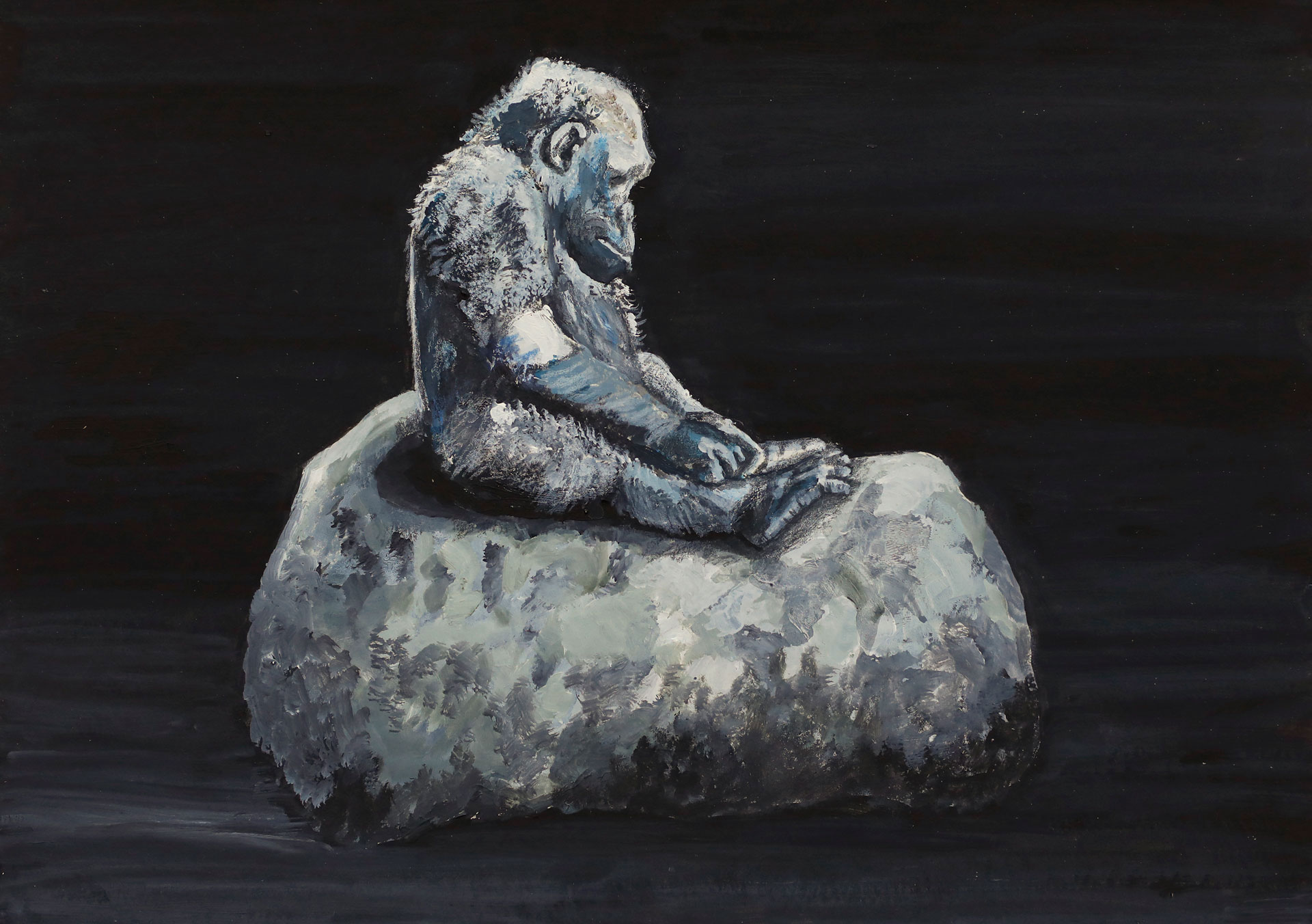
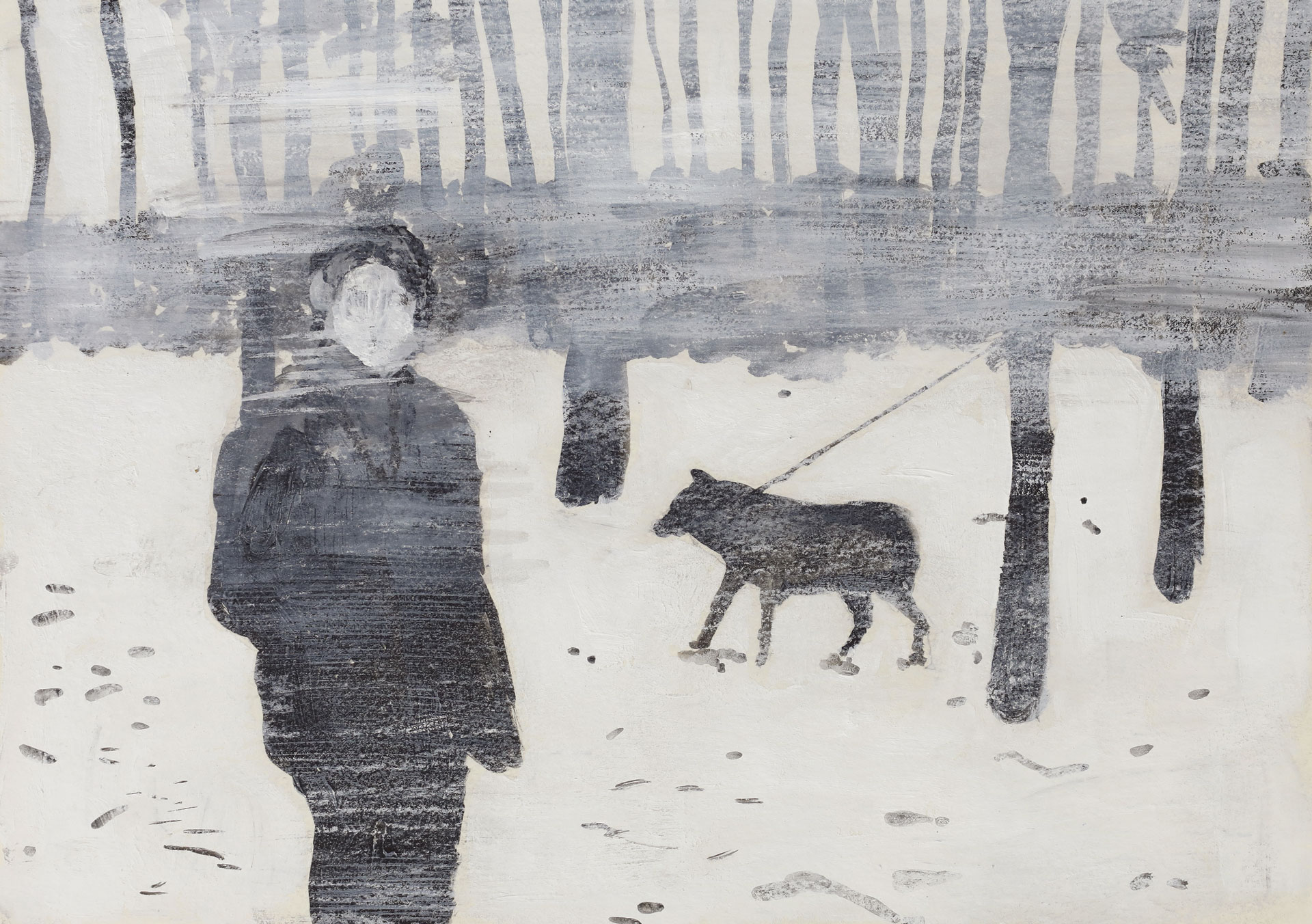
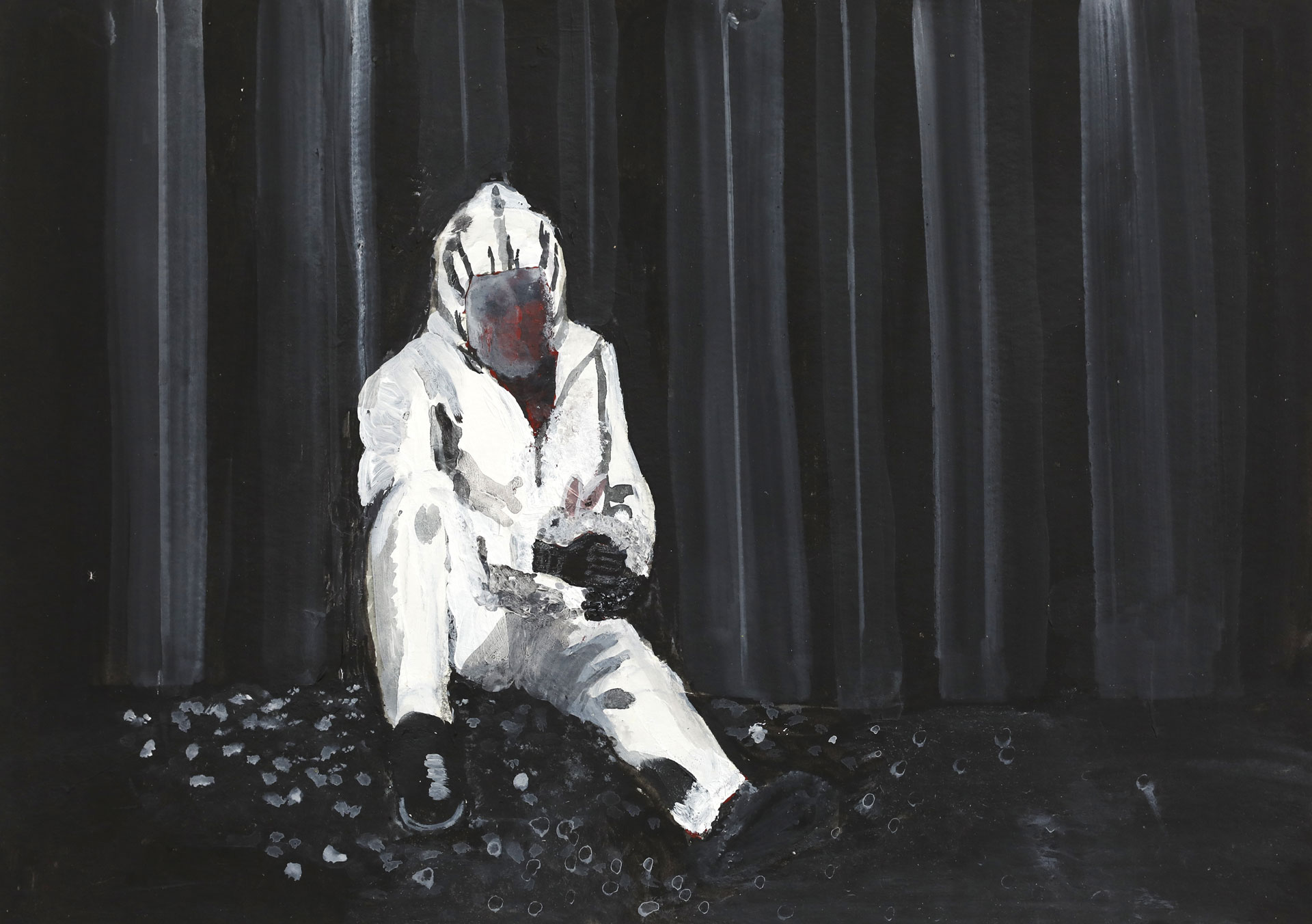
Eiland
2020
Wintertime
2020
Man in black
2020
Over Passages en passant
Passages en passant is een tijdelijke tentoonstellingsruimte in Rotterdam.
Passages en Passant strekt zich uit in het Goethe-Instituut Rotterdam in een gang die het entreegebied verbindt met de cafetaria. De doorgang heeft daklicht en is licht hellend, maar net als bij een tunnel zijn de tegenoverliggende muren zo dichtbij dat de ruimte die ze omarmen slechts een wandelgebied wordt. De blik van de voorbijganger, wanneer hij niet gefocust is op de openingen aan beide uiteinden, ontmoet de enorme muren links en rechts, die meestal geen observatie afdwingen.
Dit is waar Passages en passant graag rangschikt, test en overpeinst. In een omgeving die zeer vluchtig en praktisch is, worden kunstwerken uitgevoerd die geschikt zijn voor snel begrip en zich tegelijkertijd langzaam ontvouwen wanneer er in rust naar wordt gekeken.
In een reeks van zes tentoonstellingen wordt de gangruimte telkens ingevuld door werken van twee kunstenaars die inhoudelijk of positioneel reageren op de verschillende kwaliteiten van de ruimte en daarbij ook nieuwe relaties tussen de werken onderling voorstellen.
About Passages en passant
Passages en Passant is a temporary exhibition space in Rotterdam.
Passages en Passant stretches out in the Goethe-Institute Rotterdam in a hallway that connects the entrance area with the cafeteria. The passageway has roof lights and is slightly angled, but as with a tunnel, the opposing walls are so close that the space they embrace becomes a mere walking area. The passersby´s gaze, when not focussed on the openings at both ends, meets the huge walls to the left and right, which usually don´t compel observation.
This is where Passages en Passant likes to arrange, test and contemplate. In a setting that is highly transitory and practical, artworks are implemented that are fit for rapid comprehension and at the same time slowly unfold when being looked at with rest.
In a series of six exhibitions, with each the corridor space is rendered by the works of two invited artists that respond to the various qualities of the space’s content or by positioning, and thereby propose new relations among the works as well.
Over de mensen achter Passages en passant
Passages en Passant wordt gerund door Marco Douma en Kathrin Wolkowicz, beiden Rotterdamse kunstenaars die voortdurend een bijdrage willen leveren aan de levendige Rotterdamse kunstscene (en daarbuiten) met kunstwerken, het hosten en organiseren van evenementen en het cureren van tentoonstellingen.
Lees meer
Marco Douma is beeldend kunstenaar die zich richt op bewegend beeld en geluid. In zijn videowerk en video-installaties wordt de kijker meegevoerd naar een moment van contemplatie. Een moment om zich terug te trekken uit de hectiek van de dagelijkse realiteit en los te komen van triviale gedachten en beslommeringen. In zijn werk definieert hij de ondefinieerbare ruimte. De ruimte waar voorgrond en achtergrond in elkaar overvloeien.
Wat hem inspireert is de sensatie van vertragende bewegingen, ritme en kleuren in de (alledaagse) natuur en omgeving. Vaak dichtbij. Je ziet ze in een fractie van een seconde, een vertraagd beeld dat je gedachten even stilzet. Alsof de wereld even stilstaat. Hij vangt deze momenten en werkt ze uit. Hij wil de sensatie die hij ervaart benadrukken door het moment langer te laten duren en het om te zetten in vloeiende bewegingen. De vertraging werkt als een katalysator om je binnen enkele seconden uit je omgeving te verwijderen. Tijd en ruimte lossen op.
Het werk van Kathrin Wolkowicz strekt zich uit van performance, installatie, objecten en boeken tot film en video, en wordt meestal aangewakkerd door zelfgeschreven of aangepaste teksten. Het is een voorstel van op tijd gebaseerde of ruimtelijke situaties die uitnodigen tot het herlezen van iemands relatie met objecten en lichamen; hoe we verblijven, onze tijd doorbrengen en de ruimte delen met anderen.
Een belangrijk deel van Kathrin’s praktijk is collectief werken, als stichtend lid van Sils Projects, programmeur voor Suburban Video Lounge, onderdeel van 004-collective en Borgerstraat publicatie collectief. Voor een aantal van haar recente werken heeft ze de studio ingeruild voor de straat om met bewoners van door stadsontwikkeling getroffen gebieden een gemeenschappelijke basis te leggen.
Met ondersteuning van
Rutger Zuydervelt: ontwerp flyers en posters
Heleen Schröder: proeflezen Engels
Passages en Passant is run by Marco Douma and Kathrin Wolkowicz, both Rotterdam-based artists who continually like to contribute to Rotterdam´s vibrant art scene (and beyond) with art works, hosting and organizing events and curating exhibitions.
Read more
Marco Douma is a multidisciplinary / multimedia contemporary artist. He concentrates on (moving) image and sound, where time and space are dissolved, creating a moment of inner reflection and layers of meaning are subtly incorporated into images taken from daily life.
Marco is a member of the artist initiative Stichting B.a.d. in Rotterdam, with whom he develops national and international projects. He also frequently collaborates with Rutger Zuyderveld and Roel Meelkop in projects such as Pierdrie. He is also the founder of the multimedia agency Beeldhonger.
Kathrin Wolkowicz´s work spans from performance, installation, objects and books to film and video, and is usually kindled by self-written or adapted texts. It is a proposal of time-based or spatial situations that invite for re-reading one´s relationships with objects and bodies; how we dwell, spend our time and share the space with others.
A substantial part of Kathrin´s practice is working collectively, as founding member of Sils Projects, programmer for Suburban Video Lounge, part of 004-collective and Borgerstraat publication collective. For some of her recent works she has exchanged the studio for the street to lay out common grounds with inhabitants of areas affected by city development.
Kindly supported by
Rutger Zuydervelt: design flyers and posters
Heleen Schröder: proofreading English